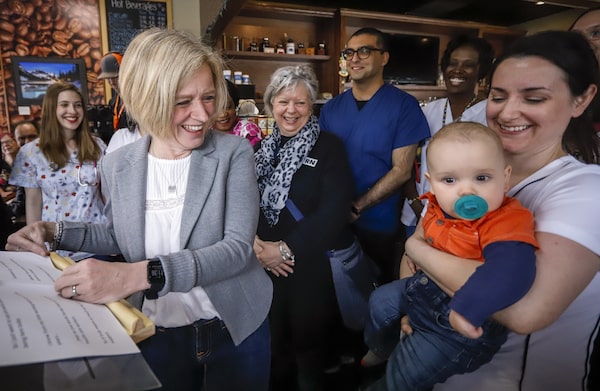
Alberta NDP leader Rachel Notley makes a campaign stop in Calgary, Alta., April 11, 2019.Jeff McIntosh/The Canadian Press
When Alberta’s NDP government banned political donations from corporations and unions shortly after taking office, the goal was to root out big money from the province’s elections.
But some of that money didn’t leave. Instead, it moved to third-party political advertisers that have collectively raised more than $1-million for the current provincial election campaign, mostly from large corporate and union donors.
Several of those advertisers, also known as political action committees, or PACs, have been overtly campaigning for specific candidates or parties on both sides of the political spectrum. There have also been allegations that third-party groups have improperly worked directly with political parties despite a ban on co-ordination.
The rise of PACs has prompted calls for more restrictions, including donation limits, for third-party advertisers.
“It’s allowing big money, be it union or corporate money, to swamp our election and have a larger say and a larger voice in our democracy than Albertans themselves,” said Alberta Liberal Leader David Khan, whose party has been calling for increased limits on third-party groups.
The governing New Democrats passed legislation in 2015 that banned corporate and union donations and limited personal donations to $4,000 a year. The law was expanded in 2017 to impose spending limits and reporting requirements on third-party advertisers.
Before the ban, corporate and union donations accounted for nearly half of all political contributions to political parties. In 2014, a non-election year, corporations and unions donated $3-million to political parties, compared with $4.2-million from individual donors, according to financial disclosures filed with Elections Alberta.
Soon after the ban, corporate- and union-funded PACs emerged to fill the gap.
Last year, PACs raised $3.7-million to spend on political advertising, with $1.8-million of that coming from corporations and $570,000 from unions. Of the $1.3-million raised by those groups for the current election period, which began in Dec. of last year, corporations donated just over $500,000 and unions were responsible for about $550,000.
Each PAC is limited to spending $150,000 in the months before the writ drops and then $150,000 during the campaign. Third-party groups cannot “collude” with political parties to skirt expense limits, though that collusion is not defined in the legislation.
There have been allegations that groups on both sides of the political spectrum have been skirting those rules.
Last year, the NDP filed a complaint with the province’s election commissioner after the Motor Dealers’ Association of Alberta sent a letter to its members urging them to donate to a group called Shaping Alberta’s Future, which has brought in the most money of any third-party advertiser and has been running ads and campaigning in favour of UCP Leader Jason Kenney. The letter said Mr. Kenney had met with the association and made several policy commitments, though the association, the UCP and Shaping Alberta’s Future denied there was anything improper.
The United Conservative Party has argued union-funded third-party groups are too close to the New Democrats. The Alberta Federation of Labour, for example, is registered as a third-party advertiser while the group also has two seats on the party’s provincial council. The AFL, whose president Gil McGowan did not respond to requests for comment, set aside nearly $110,000 of its own money, raised through union dues, for the election period.
The NDP said in a statement that “working people are represented on the NDP’s provincial council” but did not address concerns about the AFL also acting as a third-party advertiser.
Christopher Cotton, who teaches at Queen’s University and whose research focuses on campaign finance reform, said allowing corporations and unions to spend large amounts of money funding third-party groups undermines efforts to reform political financing.
“A lot of the benefits you get out of spending limits and donation limits, they go away if there are other avenues for the money to flow into provincial politics,” he said in an interview.
Dr. Cotton said imposing donation limits for third-party groups would go a long way to address those concerns.
Both the NDP and the UCP have measures in their platforms to deal with third-party groups.
The UCP would set a $30,000 donation limit on third-party groups and specifically prohibit groups with direct links to political parties such as the AFL, which is singled out in the platform, from running PACs.
The NDP platform says it would take further steps to get “dark money” out of politics but does not include more detail.
Mr. Khan, the Liberal Party Leader, said there should be donation limits for PACs and that corporate and union money should be banned entirely. He said his party tabled a bill with such restrictions but the NDP failed to act on it.
Other third-party advertisers include:
- The Alberta Teachers’ Association, which has set aside $270,000 for a campaign focused on class sizes.
- The Merit Contractors Association, whose self-funded $150,000 budget has urged voters to support the UCP.
- The Alberta Victory Fund, which has raised $145,500 and is run by Mr. Kenney’s former campaign director.
- Project Alberta, which has been running ads attacking Mr. Kenney on a $135,000 budget entirely funded by the trade union, Unifor.
- Firefighters for Alberta, which represents 17 firefighters’ unions and has endorsed the New Democrats.
With a report from Chen Wang
 James Keller
James Keller